-
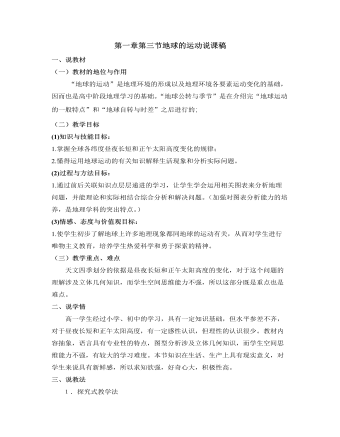
人教版高中地理必修1第一章第三节地球的运动说课稿
(一)教材的地位与作用“地球的运动”是地理环境的形成以及地理环境各要素运动变化的基础,因而也是高中阶段地理学习的基础。“地球公转与季节”是在介绍完“地球运动的一般特点”和“地球自转与时差”之后进行的;(二)教学目标(1)知识与技能目标:1.掌握全球各纬度昼夜长短和正午太阳高度变化的规律;2.懂得运用地球运动的有关知识解释生活现象和分析实际问题。(2)过程与方法目标:1.通过前后关联知识点层层递进的学习,让学生学会运用相关图表来分析地理问题,并能理论和实际相结合综合分析和解决问题。(加强对图表分析能力的培养,是地理学科的突出特点。)(3)情感、态度与价值观目标:1.使学生初步了解地球上许多地理现象都同地球的运动有关,从而对学生进行唯物主义教育,培养学生热爱科学和勇于探索的精神。
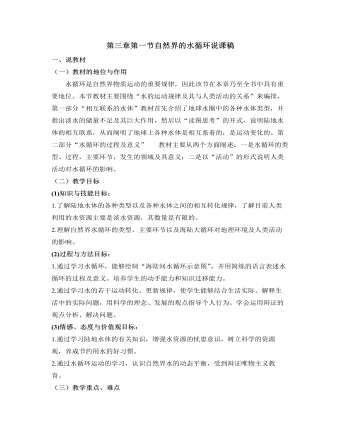
人教版高中地理必修1第三章第一节自然界的水循环说课稿
二、说学情学生对自然界中的水循环已具有一定的生活体验和知识基础,主要问题是学生还未上升到理性的层面上进行分析,而且自然界的水循环属于全球尺度和大尺度的地理现象,学生难以理解,需要教师创设适当的情境引导学生进行新知的建构。三、说教法(1)创设情景:教学实践证明,合理有趣的情境创设,可以引导学生快速进入角色,提高课堂效率(2)讨论法:通过组织学生讨论,给学生提供自主学习、合作学习、探究学习的机会。(3)多媒体演示法:利用多媒体播放一些直观的图片、动画和数字资料,把学生轻松得引入本课,通过形象生动直观地展现相关地理事物和现象,提高学生的感性认识,激发兴奋点,帮助他们理解课本内容。四、说学法(1)学会用图:让学生仔细观察图3.2和图3.3理解水循环的相关性(2)学会探究:学生思考分析总结水循环的地理意义及黄河断流的原因。
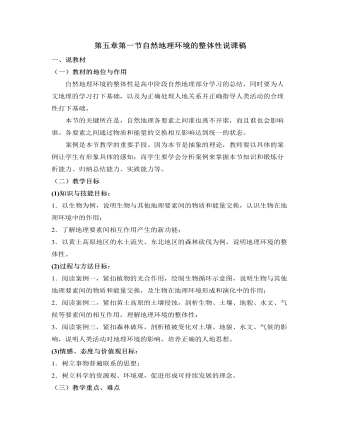
人教版高中地理必修1第五章第一节自然地理环境的整体性说课稿
学生已学习水循环和岩石圈物质循环,对地理环境要素有初步的认识,对物质迁移和能量的交换有一定的了解,已具备基本的地理阅读分析、提取信息的能力。但学生还缺乏综合分析问题解决问题的能力,通过案例来帮助学生对自然地理环境整体性的认识,还需要补充光合作用、分解作用等知识,并进一步培养学生综合分析地理问题的能力。三、说教法案例教学、启发式讲授四、说学法学生原有的地理基础知识不扎实,学习地理方法简单;但学生思维活跃,有强烈的求知欲,所以在学习的过程中,老师应充分利用这一点,调动学生的积极性,激发学生的学习兴趣。学案导学法;合作探究法;案例分析法等,自主学习、合作学习,培养学生的主动学习的能力、团队精神,增强学习效果;体会自然地理环境的整体性和复杂性,将学习目标内化到行动上。

人教版高中语文必修1《记梁任公先生的一次演讲》说课稿2篇
6、思考:作者心目中的梁启超是什么形象呢?明确:梁任公是位有学问,有文采,有热心肠的学者。由学生找出文中体现梁启超学问、文采的句子。教师展示幻灯。补充介绍:文采不仅体现在书面,也能从流畅的口语表达中反映。《箜篌引》短短十六字蕴涵了什么故事,竟让梁启超描述得生动感人以至作者多年后还印象深刻呢?《箜篌引》出自《汉乐府诗》,记叙了一个悲惨壮烈的故事:朝鲜水兵在水边撑船巡逻时,见一个白发狂夫提壶渡江,被水冲走。他的妻子劝阻不及,悲痛欲绝,取出箜篌对着江水反复吟唱。一曲终了,她也投河随夫而去。朝鲜水兵回家向自己的妻子丽玉讲述了这个故事,丽玉援引故事中的悲情,创作了这首歌曲,听过的人无不动容。7、朗读训练了解《箜篌引》的故事后,请各小组选派代表朗读,由学生点评,体会梁启超演讲技巧的高超。8、文中说梁任公是个热心肠的人,你同意吗?通过结尾段的“热心肠”转入对其人格的分析。
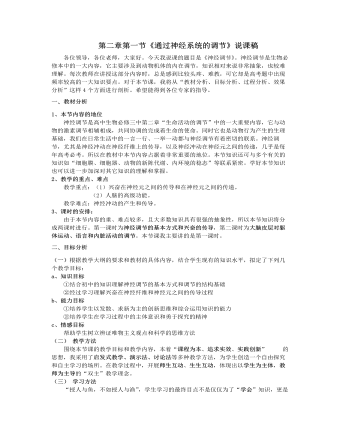
人教版高中生物必修3第二章第一节《通过神经系统的调节》说课稿
3、总结(这部分要5分钟)学生在教师的提示和问题的引导下,完成对本节课的知识的归纳和小结。利用简炼、清晰的语言,再一次的突出本节课的重点,起到画龙点睛的作用,培养了学生的表达能力。4、巩固练习(这部分要10分钟)用大屏幕投影把题目投影在屏幕上,让学生思考,然后回答。这部分安排10分钟的时间,让学生思考完成具有针对性的练习,进行知识巩固和教学效果反馈,及时纠正错误的理解和片面的认识。5、板书设计在板书中,我根据板书的“规范、工整和美观”的要求,结合所学的内容,设计了如图所示的板书。在其中,注重了重、难点的突出,使学生对知识的结构、层次、重点、难点一目了然,便于记忆和理解。四、效果分析对于反射的判断,学生仍有可能出现错误,如刺激坐骨神经肌肉的收缩,教师应强调没有完整的反射弧结构参与的不是反射。
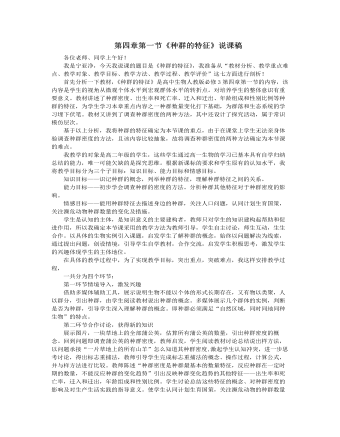
人教版高中生物必修3第四章第一节《种群的特征》说课稿
第二环节合作讨论,获得新的知识展示图片,一块草地上的全部蒲公英,估算所有蒲公英的数量,引出种群密度的概念。回到问题即调查蒲公英的种群密度,教师启发,学生阅读教材讨论总结说出样方法,以问题承接“一片草地上的所有山羊”怎么知道其种群密度,激起学生认知冲突,进一步思考讨论,得出标志重捕法,教师引导学生完成标志重捕法的概念、操作过程,计算公式,并与样方法进行比较。教师陈述“种群密度是种群最基本的数量特征,反应种群在一定时期的数量,不能反应种群的变化趋势”引出反映种群变化趋势的其他特征——出生率和死亡率,迁入和迁出,年龄组成和性别比例。学生讨论总结这些特征的概念、对种群密度的影响及对生产生活实践的指导意义。使学生认同计划生育国策,关注濒危动物的种群数量变化。之后引导学生构建种群特征的关系图。再简明阐述种群空间特征即:随即分布,均匀分布、集群分布。第三环节反馈练习,巩固新知识通过对学生练习结果的评价,了解学生对知识的掌握情况。即以学生为核心的教学评价。
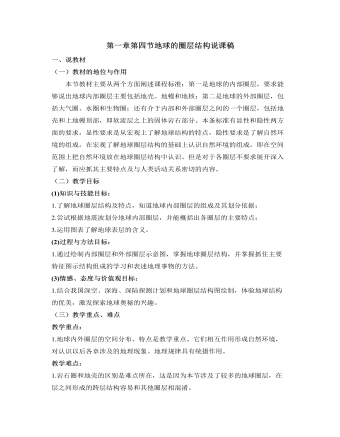
人教版高中地理必修1第一章第四节地球的圈层结构说课稿
(一)教材的地位与作用本节教材主要从两个方面阐述课程标准:第一是地球的内部圈层,要求能够说出地球内部圈层主要包括地壳、地幔和地核;第二是地球的外部圈层,包括大气圈、水圈和生物圈;还有介于内部和外部圈层之间的一个圈层,包括地壳和上地幔顶部,即软流层之上的固体岩石部分。本条标准有显性和隐性两方面的要求,显性要求是从宏观上了解地球结构的特点,隐性要求是了解自然环境的组成。在宏观了解地球圈层结构的基础上认识自然环境的组成,即在空间范围上把自然环境放在地球圈层结构中认识。但是对于各圈层不要求展开深入了解,而应抓其主要特点及与人类活动关系密切的内容。(二)教学目标(1)知识与技能目标:1.了解地球圈层结构及特点,知道地球内部圈层的组成及其划分依据;2.尝试根据地震波划分地球内部圈层,并能概括出各圈层的主要特点;3.运用图表了解地球表层的含义。
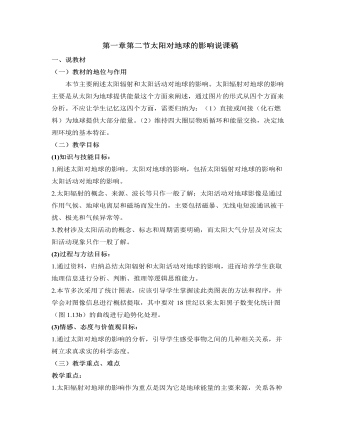
人教版高中地理必修1第一章第二节太阳对地球的影响说课稿
(一)教材的地位与作用本节主要阐述太阳辐射和太阳活动对地球的影响。太阳辐射对地球的影响主要是从太阳为地球提供能量这个方面来阐述,通过图片的形式从四个方面来分析。不应让学生记忆这四个方面,需要归纳为:(1)直接或间接(化石燃料)为地球提供大部分能量。(2)维持四大圈层物质循环和能量交换,决定地理环境的基本特征。(二)教学目标(1)知识与技能目标:1.阐述太阳对地球的影响。太阳对地球的影响,包括太阳辐射对地球的影响和太阳活动对地球的影响。2.太阳辐射的概念、来源、波长等只作一般了解;太阳活动对地球影像是通过作用气候、地球电离层和磁场而发生的,主要包括磁暴、无线电短波通讯被干扰、极光和气候异常等。3.教材涉及太阳活动的概念、标志和周期需要明确,而太阳大气分层及对应太阳活动现象只作一般了解。

人教版高中地理必修2第三章第一节农业的区位选择说课稿
◆设计意图:培养学生独立思考、合作学习的能力。分别说明市场、交通、劳动力、机械和政策对农业生产的影响,让学生切实地考虑,拓展学生思路。教师激发和维持学生学习动机、引导学生、帮助学生自主发现、探索知识,达到巩固所学知识,检验学生的实践应用能力。D.分析教材,识别图片,理解农业地域阅读、分析教材,看图识别,研究案例《澳大利亚地混合农业生产》、思考问题、解决问题◆设计意图:图片展示能清楚直观地说明问题,通过案例分析,了解澳大利亚的混合农业生产,培养学生独立思考问题、解决问题的能力,开拓学生思路。3.课堂小结:◆设计意图:帮助学生回顾课堂、巩固所学知识。4.反馈练习:◆设计意图:知识与能力强化训练,巩固本课所学知识,提高应用能力。
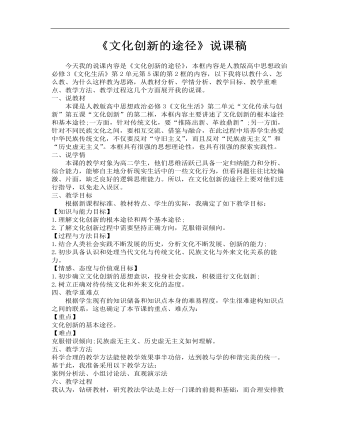
高中思想政治人教版必修三《文化创新的途径》说课稿
二、说学情本课的教学对象为高二学生,他们思维活跃已具备一定归纳能力和分析、综合能力,能够自主地分析现实生活中的一些文化行为,但看问题往往比较偏激、片面,缺乏良好的逻辑思维能力。所以,在文化创新的途径上要对他们进行指导,以免走入误区。三、教学目标根据新课程标准、教材特点、学生的实际,我确定了如下教学目标:【知识与能力目标】1.理解文化创新的根本途径和两个基本途径;2.了解文化创新过程中需要坚持正确方向,克服错误倾向。
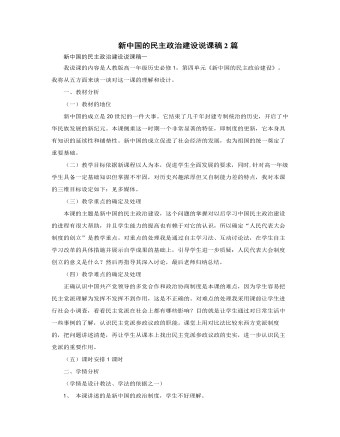
人教版高中历史必修1新中国的民主政治建设说课稿2篇
(一)教材的地位新中国的成立是20世纪的一件大事。它结束了几千年封建专制统治的历史,开启了中华民族发展的新纪元。本课侧重这一时期一个非常显著的特征,即制度的更新,它本身具有知识的延续性和铺垫性。新中国的成立促进了社会经济的发展,也为祖国的统一奠定了重要基础。(二)教学目标依据新课程以人为本,促进学生全面发展的要求,同时,针对高一年级学生具备一定基础知识但掌握不牢固,对历史兴趣浓厚但又自制能力差的特点,我对本课的三维目标设定如下:见多媒体。(三)教学重点的确定及处理本课的主题是新中国的民主政治建设,这个问题的掌握对以后学习中国民主政治建设的进程有很大帮助,并且学生能力的提高也有赖于对它的认识,所以确定“人民代表大会制度的创立”是教学重点。
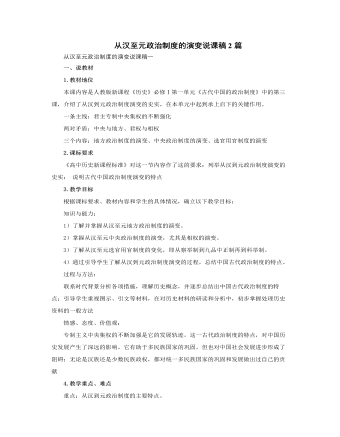
人教版高中历史必修1从汉至元政治制度的演变说课稿2篇
二、君主专制的演进(即中央政治制度的演变)通过地方政治制度演变的学习,掌握方法以后,以学生归纳整理基本线索为主,教师适当点拨,注意纠错。1. 汉承秦制,又有所变化。教师点拨强调继承与发展两个方面。创设情景:同学们看了电视连续剧《汉武大帝》后,知道汉武帝刘彻在继位之后,就急于对西汉王朝的政治制度进行改革。那么,西汉初期中央政治制度的基本框架是怎样的呢?汉武帝为什么要对它进行改革呢?改革后的西汉中央集权制度又是怎样的呢?请大家议一议,想一想。主干知识:西汉初期的中央政治制度的最大特点是“汉承秦制”。具体表现在两个方面:一是继续实行皇帝制度,维护皇权,这一做法也为后来各王朝所沿用;二是在中央设立三公,分别掌管行政、监察和军事。到汉武帝时,“中朝”成为西汉重要的中央决策机构,尚书令的权力日益重要,以丞相为首的三公九卿的权力被削弱,演化为执行机构。到了东汉光武帝时,进一步剥夺三公权限,扩大尚书的权力。

人教版高中历史必修1资本主义政治制度在欧洲大陆的扩展说课稿
1789年法国大革命后,共和派与君主派之间进行了长期反复的斗争,直到1875年法兰西第三共和国宪法通过才最终确立了共和政体,它为法国资本主义的进一步发展奠定了基础。专制色彩浓厚的普鲁士通过王朝战争这种自上而下的形式,完成了德国的统一。1871年德意志帝国宪法颁布,德国君主立宪政体确立,保留了浓厚的专制残余和军国主义传统。但资产阶级代议制的建立使德国的资本主义工业迅速发展起来,19世纪末跻身到世界强国行列。资本主义政治制度扩展到了欧洲大陆,随着这两个国家资本主义政治制度的确立,近代西方主要资本主义政治制度得以最终确立。四、板书一、法国共和政体确立的艰难历程1、艰难 (1)表现 (2)原因2、确立标志:法兰西第三共和国宪法

人教版高中历史必修1夏、商、西周的政治制度说课稿3篇
二、教学目标:(一)知识与能力:学生了解夏商周期的政治制度的内容和特点,对不同的政治制度有一个较为全面的认识。在此基础上,学生根据所学的知识,归纳和评价从夏到周政治发展的特点以及内在规律。(二)过程与方法:在学习的过程中,采用小组合作讨论的形式,让学生学会与他人合作与沟通,提高自主探究的技能。(三)情感态度与价值观:政治制度的不断更新是古人制度创新的结果,而这种制度的不断更新也推动文明的发展。这是古代先民的智慧结晶,学生要引以为豪。而通过本课的学习,可以增强学生们的民族自豪感。三、说教科书:本课作为高中历史教材的开篇,是认识整个古代政治文明史的起点,具有统领和示范作用。本课总共有三个子目,主要讲述了夏商周的政治制度。主要介绍了夏朝公共权力的出现,分封制的内容、分封的对象、 “以嫡长子继承制为核心的宗法制度”介绍了宗法制的来源、内容,以及礼乐制度的大致内容。

人教版高中英语必修4Women of achievement说课稿4篇
Good morning, distinguished judges:It’s my honor to talk about my teaching ideas with you. Today my topic is Women of Achievement. My presentation consists of six parts: the analysis of teaching material and student, teaching aims, key and difficult points, teaching and studying method, teaching procedures and blackboard design.First, let’s focus on the analysis of teaching material. This lesson is from New Senior English for China Student’s Book 4 Unit 1, the reading part. The main topic of the passage is the introduction of a student of Africanwildlife. After this lesson, the students will learn more information about her studying chimps in Africa, and their reading and speaking abilities can be developed as well.The next part is the analysis of students. My students are in senior high students. They have learnt English for many years, they’ve known many words and sentences, but their speaking and reading abilities are still not very good. So I will practice their speaking and reading abilities through different exercises.According to the New Standard Curriculum and the present situation, I set the teaching aims as follows: firstly, knowledge aims. Students can grasp some new words, such as worthwhile, move off. Moreover, students can understand the content of the passage and get familiar with the topic of studying chimps in wildlife. Secondly, ability aims. Students can use reading strategies such as skimming and scanning in reading process. Thirdly, emotional aims. Students can have the awareness of protecting animals and care about animals.Based on the above analysis, the key point of this lesson is to get the main idea and the detailed information from the passage; the difficult point is to talk about the wildlife protection and use reading strategies.

人教版高中英语必修4Body Language说课稿4篇
Textbook: Senior English for China (Book 4), by Liu Daoyi Time Allotment: 1 period (40 minutes)Date: March 20, 2014Teaching aids: blackboard, Multi-media, Power Point, chalk I. Text Analysis (教材分析)This unit is about body language, and the text selected in the reading part demonstrates the difference and similarity of body language in many parts of the world. Through learning this passage, students are required to raise their awareness of using body language in different parts of the world. As body language is closely related to our daily life, it is easy to arouse students’ interest in learning this text. Reading skills and speaking training are designed around the text.II. Teaching Objectives (教学目标)By the end of the lesson, students will be able to:1. Language Skill Objective(语言技能目标): develop reading ability (skimming and scanning)as well as speaking ability.2. Cultural Knowledge Objective(文化知识目标): know about the cultural differences of using body language.3. Affective Objective(情感目标): increase students’ awareness of using body language correctly in different cultures. III.Teaching Focuses and Difficulties(教学重点和难点)1. Teaching Focuses(教学重点): the difference and similarity of body language in many parts of the world.2. Teaching Difficulties(教学难点): develop students’ reading abilities of skimming and scanning and ask the students to show their opinions with fluent English.

人教版高中英语必修5Great scientists说课稿4篇
通过写文章梗概,培养学生综合运用语言的能力,学习用恰当的英语描述科学家的故事。这是本课的教学难点。教师可以使用完形填空的方式来帮助学生整理语篇,从而来降低难度。本课的教学重点的突破方法是:在阅读前,让学生初步了解得出科学观点所需要的基本程序,从而轻松而自然地导入文章的阅读;在阅读过程中,由易到难设计快速阅读和精读的问题,层层推进各种阅读活动,让学生对阅读内容从整体感知到细节理解,最后深层读懂整篇文章,同时加强阅读策略的指导,让每个学生都主动参与课堂教学活动,最终达到提高阅读能力的目的。Step 4 Post-readingGroup Activities四人小组共同合作,在老师的适当指导下,就以下2个问题展开讨论,让学生就所知、所学、所感和所想融入话题,然后抽若干同学代表作小组发言。1. What do you think about John Snow, and what should we learn from him?2. Cholera was 19th century disease, which two diseases are similar to cholera today? Why?

人教版高中英语必修3Canada-the true north说课稿4篇
Good afternoon, teachers, It’s my great pleasure to be here sharing my lesson with you.The content of my lesson is Senior English Book 3 Unit 5 Canada —— “The true North”.I’ll be ready to begin this lesson from five parts. Analysis of the teaching material,the teaching methods,the studying methods, the teaching procedure,and Blackboard design.First, let me talk about the teaching material.Part 1 Teaching Material:This unit is about the introduction of Canada. By studying of this unit,we’ll enable the students to learn the geography, population, main cities, and natural beauty, natural resources of Canada. Through the training of the unit, it also requires students to learn some Language skills such as the expressions of position and emotions.So it plays an important part in the English teaching in this book.After studying the teaching material and analyzing the rule of children’s growing of mind,I think the teaching aims are the followings:1.Knowledge objects:(1) make the students learn some new words and phrases(2) make the students understand the content of the lesson.2.Ability objects:(1)To develop the Ss’ abilities of listening, speaking, reading and writing. Especially reading and speaking ability.(2) learn to talk about the characters of Canada in English(3)To train the Ss’ ability of working in pairs.3.Emotion objects:(1)Enable students to understand the characters of Canada..(2)Stimulate Ss to work hard to make China stronger.Part 2 Teaching Methods:I think helping students learn to master new words and phrases and improve the students’ reading and speaking ability is import and the difficult.According to the analysis of the teaching material and the import points and the difficult points,I will use the following teaching methods : question-guiding approach; fast-reading and careful reading; multi-media teaching methods; discussion

人教版高中英语必修4Theme parks说课稿3篇
The oldest and the most popular park in the worldenjoy the exciting activities thereget close to the life-size cartoon characters like Mickey Mouse and Donald Duck Step 3 Pre-reading1.What do you suppose a theme park is ?2.What do you think you can see in a theme park?(1.It is a kind of amusement park which has a certain theme – that the whole park is based on. 2.buildings, castles, statues, rare animals and birds, and so on.) Step 4 Reading ----- Theme Parks –---- Fun and More Than Fun1.Predict : Read the title and the pictures on P. 34 and PredictWhat is the meaning of the title “Theme Park – Fun and more than fun”?(The title means that theme parks are fun to visit, but that they can also be educational and can offer useful information.)2.Skimming Fast read and answer:What activities can we take in a theme park?Amusement park: Bumper car Merry-go-round slide bungee jumping Free-fall rides Horror films Pirate ship Ferris wheel roller coaster3.Scanning Read again and you will find various theme parks are mentioned in the passage . Then what are they ?Theme parks: Sports theme park History theme park Culture theme park Marine or Ocean theme Park Future park Science theme park Disneyland4.Careful reading and find the main idea of each paragraph:THEME PARKS---- entertaining/ educationalPara.1 Traditional parks are places to go for relaxation and to have time away from our busy lives.Para.2 Theme parks are different They’re large and full of things to do, see and buy.Para.3 Theme parks are built around a single idea or theme. One example is a sports park.Para.4 Another kind of theme park is historical more and cultural and can be educational.Para.5 Disneylandwas the first theme park. It is based on the fantasy life and characters of Disney’s films.Para.6 Some examples of educational theme parks include sea world parks and science parks.

人教版高中英语必修3Healthy Eating说课稿4篇
Language learning needs a context, which can help the learners to understand the language and then can product comprehensible output, so computer has the advantages to make the materials attractive.Part 3 Learning MethodsTask-based, self-dependent and cooperative learningPart 4 Teaching ProcedureStep One Lead-in“Interest is the best teacher.” Therefore, at the very beginning of the class, I should spark the students’ mind to focus on the centre topic “the band”. I’ll show some pictures of food to attract their attention and then bring some questions.Question:What kind of food they like?What should go into a good meal?The answers must relate to the diet. After this, the students will be eager to know something about a balance diet and this is the very time to naturally lead the class into Step 2Step 2 Reading for information: skimming and scanning In this step, I use Task-based Language Teaching method, which can give students a clear and specific purpose while skimming and scanning the context.Task 1 General ideaThe students will be asked to just glance at the title and the pictures of the passage, and then guess what they will read in the text. And they’ll be divided into groups of four to have a discussion.The purpose is to inspire the students to read actively, not passively. In addition, the task is to develop the students’ reading skill by making prediction and to encourage the students to express their thoughts in English and cooperate with each other.Task 2 Main idea of each paragraphCooperative learning can raise the students’ interest and create an atmosphere of achievement. Based on this theory, I divide the whole class into 4 groups to skim the whole text and get the main idea of each paragraph.